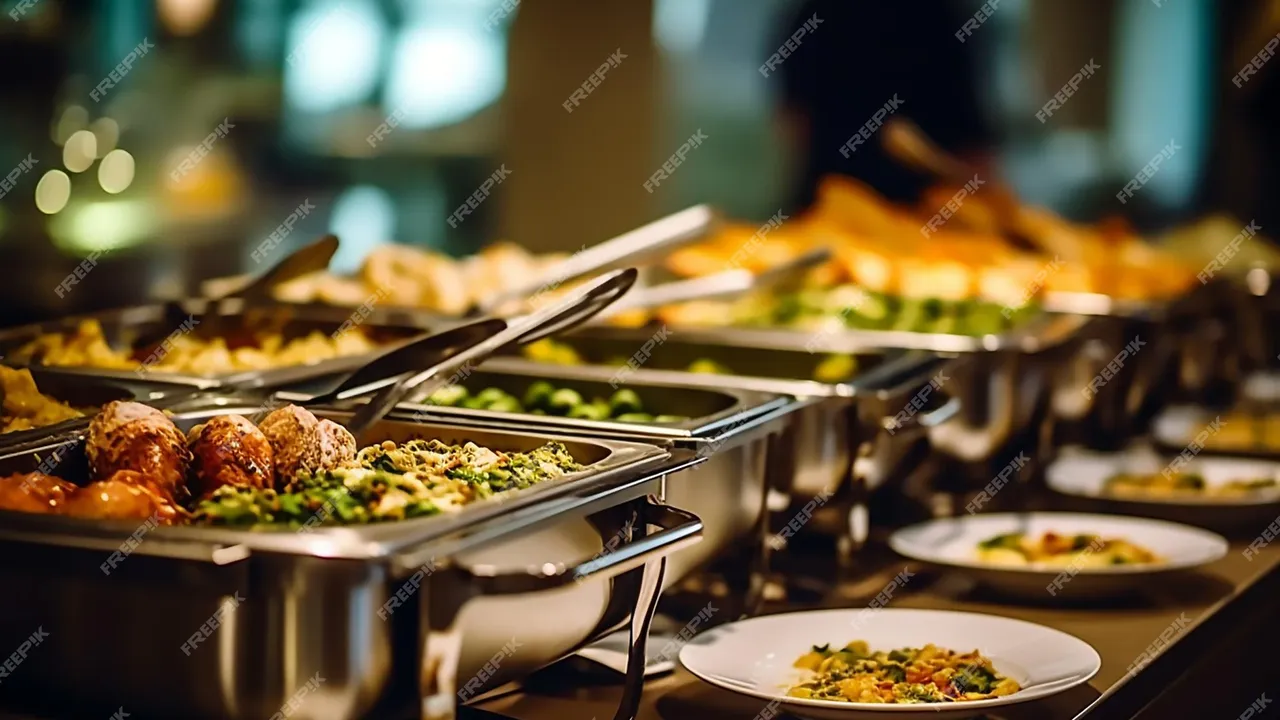Buffet Style Entertaining 5 Smart Layout Ideas
Master buffet style entertaining with these 5 smart layout ideas. Ensure smooth flow and easy access for your guests.

Buffet Style Entertaining 5 Smart Layout Ideas
Understanding the Flow of a Buffet Line
Before diving into specific layouts, it's crucial to understand the natural progression of a buffet line. Guests typically start with plates, then move to main dishes, sides, bread, and finally, cutlery and napkins. Drinks are often placed separately to avoid congestion. Desserts are usually served after the main meal, either at a separate station or brought out later. Keeping this flow in mind will help you design an intuitive and efficient setup.Layout Idea 1 The Linear Classic A Straightforward Approach
This is the most common and perhaps the simplest buffet layout. All dishes are arranged in a single, straight line. It's effective for smaller gatherings or when space is limited. The key here is to ensure enough space for guests to queue comfortably without feeling cramped.Pros: Easy to set up, intuitive for guests, works well in narrow spaces.
Cons: Can create long lines for larger groups, limited interaction between guests while serving.
Optimizing the Linear Layout for Efficiency
To make the linear layout more efficient, consider placing plates at the very beginning, followed by main courses, then sides, and finally, condiments and cutlery. Drinks should be on a separate table. For a party of 20-30 guests, a 6-8 foot table is usually sufficient. For larger groups, consider two parallel lines or a U-shaped setup.Recommended Products for Linear Buffets
- Chafing Dishes: Essential for keeping hot food hot.
- Comparison:
- Sterno 20504 Weekender Chafing Dish Set (Disposable): Around $20-30 for a set of 3. Great for casual, one-time use. Easy cleanup.
- TigerChef Stainless Steel Chafing Dish (Reusable): Around $60-100 per unit. Durable, professional look, ideal for frequent use. Requires fuel canisters (e.g., Sterno Canned Heat, around $15 for a 6-pack).
- Serving Utensils: Tongs, spoons, ladles for each dish.
- Comparison:
- Amazon Basics Stainless Steel Serving Utensil Set: Around $20 for a 6-piece set. Good value, basic functionality.
- OXO Good Grips Stainless Steel Serving Tongs: Around $15-20 per pair. Ergonomic design, better grip, more durable.
- Plates and Cutlery: Consider disposable for easy cleanup or reusable for an eco-friendly touch.
- Comparison:
- Chinet Classic White Dinner Plates (Disposable): Around $15-25 for 100 plates. Convenient, sturdy paper.
- Bamboo Dinnerware Set (Disposable/Compostable): Around $30-50 for 50 plates. Eco-friendly, rustic look.
- Corelle Livingware Dinnerware Set (Reusable): Around $40-60 for a 16-piece set. Durable, lightweight, chip-resistant.
Layout Idea 2 The Double Sided Approach Maximizing Throughput
If you have a larger gathering or a wider table, a double-sided buffet can significantly speed up the serving process. Guests can approach the table from both sides, effectively doubling the serving capacity. This layout is particularly useful for events with 50+ guests.Pros: Reduces wait times, allows for more guests to serve simultaneously, good for larger spaces.
Cons: Requires a wider table or two tables placed back-to-back, careful consideration of dish placement to ensure symmetry.
Implementing a Double Sided Buffet Effectively
For this layout, ensure that identical dishes or complementary items are placed on both sides of the table. For example, if you have a main dish of roasted chicken, place a chafing dish with chicken on both sides. Sides can also be duplicated. This prevents guests from having to reach across the table or wait for the other side to clear. Consider placing drinks and desserts at separate stations to further alleviate congestion.Product Considerations for Double Sided Buffets
- Multiple Chafing Dishes: You'll likely need double the amount compared to a linear setup.
- Serving Platters and Bowls: Ensure you have enough to duplicate key dishes.
- Table Linens: A wider table might require custom or multiple tablecloths.
- Comparison:
- Disposable Plastic Tablecloths: Around $10-20 for a pack of 3. Convenient, but can look less formal.
- Polyester Fabric Tablecloths: Around $20-40 per cloth. Reusable, more elegant, available in various sizes.
Layout Idea 3 The U Shaped Configuration Creating a Central Hub
The U-shaped layout is excellent for medium to large gatherings (30-70 guests) and provides a more contained and interactive serving area. It typically involves three tables arranged in a 'U' shape, with guests entering from one end and exiting from the other. This design naturally guides the flow and can create a more intimate feel.Pros: Excellent flow management, encourages interaction, can accommodate more dishes, good for larger spaces.
Cons: Requires significant floor space, can be tricky to set up in irregular rooms.
Designing Your U Shaped Buffet
Place plates at the entrance of the 'U'. The main dishes can be positioned along the longer side, with sides and salads on the shorter sides. Condiments, bread, and cutlery can be placed at the end of the 'U' before the exit. This layout allows for a clear progression and minimizes backtracking. You can also use the inner space of the 'U' for decorative elements or additional serving stations (e.g., a carving station).Essential Items for a U Shaped Buffet
- Multiple Tables: You'll need at least three tables (e.g., two 6-foot rectangular tables and one 4-foot rectangular table for the connecting side).
- Food Warmers/Slow Cookers: In addition to chafing dishes, slow cookers are great for keeping certain dishes warm without direct flame.
- Comparison:
- Crock-Pot 6-Quart Programmable Slow Cooker: Around $50-70. Versatile for stews, chili, pulled pork.
- Proctor Silex 1.5 Quart Slow Cooker (Mini): Around $15-25. Good for smaller side dishes or dips.
- Tiered Serving Stands: Add height and visual interest while saving space.
- Comparison:
- Amazon Basics 3-Tier Serving Stand: Around $25-40. Simple, functional, good for appetizers or desserts.
- Libbey Selene 3-Tier Glass Server: Around $30-50. More elegant, suitable for formal events.
Layout Idea 4 The Island Buffet A Central Hub for Interaction
An island buffet involves placing a central table or multiple tables in the middle of the room, allowing guests to circulate around it. This layout is highly interactive and works well for larger, more open spaces. It encourages guests to move freely and can prevent long, stagnant lines.Pros: Excellent for large gatherings, promotes mingling, visually appealing, flexible for different dish types.
Cons: Requires ample open space, can be confusing for guests if not clearly organized.
Designing an Effective Island Buffet
With an island buffet, you can create distinct zones for different food categories. For example, one side could be for main courses, another for salads and cold dishes, and a third for bread and condiments. Plates can be placed at multiple entry points around the island. Ensure there's plenty of space for guests to walk around the table without bumping into each other. Consider placing drinks and desserts on separate, smaller satellite tables around the room.Key Products for Island Buffets
- Large Serving Bowls and Platters: To accommodate dishes accessible from all sides.
- Food Labels: Crucial for guiding guests and identifying dishes, especially if you have dietary restrictions to consider.
- Comparison:
- Mini Chalkboard Signs with Stands: Around $10-20 for a pack of 10. Reusable, rustic charm.
- Disposable Tent Cards: Around $5-10 for 50. Simple, cost-effective.
- Decorative Elements: Centerpieces, floral arrangements, or themed decor to enhance the visual appeal of the central island.
Layout Idea 5 The Scattered Stations A Modern and Flexible Approach
Instead of one continuous buffet line, the scattered stations approach involves setting up multiple smaller food stations throughout the entertaining area. This is a modern and highly flexible option, perfect for very large gatherings or when you want to encourage guests to explore different areas of your home or venue.Pros: Eliminates long lines, encourages movement and mingling, allows for diverse food offerings, highly customizable.
Cons: Requires more setup and cleanup, guests might miss some stations if not clearly guided, can feel less cohesive if not well-planned.
Implementing Scattered Stations Successfully
Designate specific areas for different types of food. For example, a 'Taco Bar' station, a 'Pasta Station,' a 'Salad Bar,' and a 'Dessert Bar.' Each station should have its own plates, cutlery, and napkins. This approach works wonderfully for themed parties or when catering to diverse dietary preferences. Ensure clear signage for each station and consider placing a map or guide for guests, especially in larger venues.Product Recommendations for Scattered Stations
- Specialty Serving Equipment: Depending on your stations, you might need specific items.
- Examples:
- Taco Bar Holders: Around $15-25 for a set of 4. Keeps tacos upright and organized.
- Soup Tureens with Ladles: Around $30-60. Elegant for serving soups or stews.
- Portable Induction Cooktops: For live cooking stations (e.g., pasta, stir-fry).
- Comparison:
- Duxtop 1800W Portable Induction Cooktop: Around $70-100. Fast heating, precise temperature control, energy efficient.
- NuWave PIC Gold Portable Induction Cooktop: Around $100-150. More advanced features, often comes with a pan.
- Beverage Dispensers: For self-serve drinks at each station or a dedicated drink station.
- Comparison:
- Creativeware 2.5 Gallon Beverage Dispenser: Around $20-30. Basic, functional, good for water or iced tea.
- Estilo Glass Beverage Dispenser with Spigot: Around $30-50. More elegant, suitable for infused water or cocktails.
- Small Trash Cans/Bins: Strategically placed near each station for easy disposal of plates and napkins.
:max_bytes(150000):strip_icc()/277019-baked-pork-chops-with-cream-of-mushroom-soup-DDMFS-beauty-4x3-BG-7505-5762b731cf30447d9cbbbbbf387beafa.jpg)





